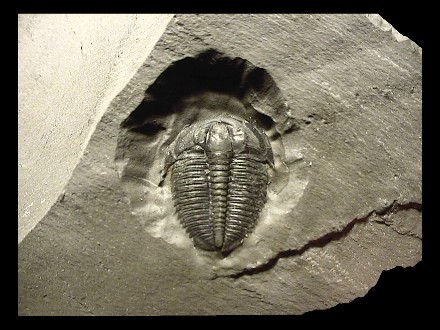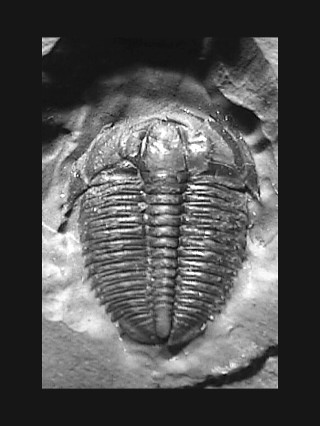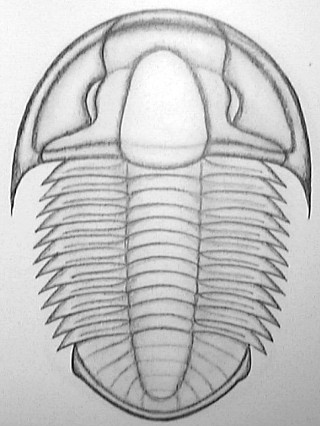|
Order
|
Ptychopariida
|
SWINNERTON 1915
|
A large, heterogenous order, with
classification problems. Occurence : Cambrian to Upper Ordovician.
- Cephalon : Generally bearing genal spines.
- Typically opisthoparian facial sutures
- Gently forward-tapering simple glabella bearing a broad, rounded front.
- Usually 3 pairs of rather narrow parallel glabellar furrows.
- Natant hypostome (some forms conterminant).
- Rostral plate shorter than the glabellar length.
- Thorax : Typically large, with 8+ thoracic segments.
- No fulcræ.
- Pygidium : Quite variable, without noticeable structures.
- Typically with a small pygidium bearing a border with terrace lines
(Cambrian forms) or a larger pygidium, with or without border (post-Cambrian
forms).
|
|
Suborder
|
Ptychopariina
|
RICHTER 1933
|
Paraphyletic primitive Ptychopariida, a large and extremely plesiomorphic
group.
- Cephalon : Glabella usually tapering or barrel-like.
- Usually 3 pairs of glabellar furrows.
- Sutures typically opisthoparian (but some proparian, and blind forms
marginal)
- Anterior sutures usually convergent to slightly divergent, posterior
sections moderately to highly divergent.
- Eyes usually present, medial, and near glabella
- Usually blade-like genal spines present.
- Relatively narrow rostral plate.
- Thorax : Generally long, relative to pygidium.
- Pygidium : Micropygous to subisopygous.
|
|
Superfamily
|
Ptychoparioidea
|
MATTHEW 1887
|
Occurence : Cambrian to Ordovician. Forms with oval, elongate, exosqueleton.
- Cephalon : Semi-circular.
- Opisthoparian sutures.
- Typically with well-defined border.
- Glabella tapering forward, bearing 3 to 4 pairs of glabellar furrows.
- Preglabellar field present, convex or flat.
- Natant hypostome.
- Short to medium sized genal spines.
- Eye ridges usually present.
- Exceptions include eyeless forms (Conocoryphidae), proparian forms
(Norwoodiidae), rounded genal angles and gonatoparian sutures (Menomoniidae).
- Thorax: Relatively broad.
- Typically 12 to 17 segments.
- Pygidium : Micropygous but exceptionally isopygous (e.g., some
Asaphiscidae, Cooselidae).
- Transverse, pleural field nearly flat, with distinct pleural grooves;
- Few segments.
- Devoid of border.
|
|
Family
|
Alokistocaridae
|
RESSER 1939
|
Occurence : Lower Cambrian to Upper Cambrian.
- Cephalon : Preglabellar area wide.
- Glabella somewhat taperring.
- Facial sutures rather deeply concave opposite the glabella.
- Eye ridges well developped.
- Palpebral lobes small.
- Genal spines of moderate size.
- Pygidium : Micropygous.
|
|
Genus
|
Elrathia
|
WALCOTT 1924
|
- Cephalon : Alokistokarid with rather wide cranidium.
- Strong eye ridges.
- Longitudinal striæ on wide preglabellar area.
- Commonly tubercules on cranidium.
- Pygidium : Relatively large.
- Few segments.
- Little developped segmentation.
|
|
Species
|
marjumi
|
ROBISON
|
A small to medium sized trilobite.
- Cephalon : Anterior border of cranidium sharply upturned.
- Glabella large and rounded anteriorly.
- Genal spines generaly extanding to the 3rd thoracic segment.
- Palpebral lobes about 1/3rd glabellar length.
- Thorax : 12 segments (in contrast to E. kingi,
which has 13).
- Pygidium : 5 axial rings.
- Long terminal piece.
- No medium notch on posterior margin.
- Incipient anterolateral spines.
|


